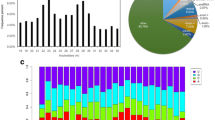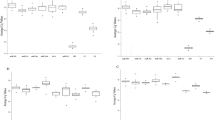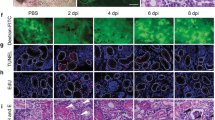Abstract
c-myc has a crucial function in growth control, differentiation, and apoptosis of vertebrate cells. Despite the important role of c-myc in mediating the biological effects, studies of c-myc gene expression and factors that control it in organisms other than mammals, such as fish, have been rare. In the current study, we asked whether c-myc mRNA of whitefish, a feasible organism for pollution monitoring in aquatic systems and a model in toxicological research, contains activity sites for regulatory motifs in its 5′- and 3′-UTRs, similar to those found in mammals. We were particularly interested in whether miRNA-34, a known negative regulator of c-myc’s in mammals, is able to regulate c-myc in fish. To answer these questions, we determined the mRNA sequence of whitefish c-myc and inferred the structure of the protein that it codes for. We found that the active sites of mRNA and structures of the inferred c-myc protein are similar to those found in mammals and other fish. Remarkably, levels of c-myc mRNA expression were very high in ovaries compared to other tissues of whitefish, thus corroborating previous data in fish. Using bioinformatic searches on c-myc 3′-UTR, we confirmed the presence of two miRNA-34a (miR-34a) response elements. Luciferase reporter assay showed that activity of reporters containing either the miR response elements or entire c-myc 3′-UTR was significantly reduced (p < 0.001) by ectopic expression of miR-34a. Therefore, we further investigated possible involvement of miR-34a in c-myc gene silencing by profiling the expression of both genes in livers of whitefish treated for 8, 24, 48 h with MC-LR, a potent c-myc inducer in mammals. Although the difference was only significant at p = 0.08, the expression of c-myc mRNA in challenged whitefish after 24 h of the treatment was notably higher than that in livers of control fish. Concurrently, we noticed slight but significant up-regulation of miR-34a after 24 and 48 h of the challenge (p < 0.05); however, we found no significant correlation of the c-myc mRNA levels and miR-34a expression. Together, these results suggest that miR-34a might regulate c-myc gene expression in whitefish liver; however, their involvement in MC-LR hepatotoxicity should be clarified in future studies.






Similar content being viewed by others
References
Arukwe A (2006) Toxicological housekeeping genes: do they really keep the house? Environ Sci Technol 40:7944–7949
Biggar KK, Wu CW, Storey KB (2014) High-throughput amplification of mature microRNAs in uncharacterized animal models using polyadenylated RNA and stem-loop reverse transcription polymerase chain reaction. Anal Biochem 462:32–34
Bjourson AJ, Cooper JE (1992) Band-stab PCR: a simple technique for the purification of individual PCR products. Nucleic Acids Res 20:4675
Brennecke J, Stark A, Russell RB, Cohen SM (2005) Principles of microRNA-target recognition. PLoS Biol 3:e85
Brzuzan P, Woźny M, Ciesielski S, Łuczyński MK, Góra M, Kuźmiński H, Dobosz S (2009) Microcystin-LR induced apoptosis expression mRNA of p53 and cdkn1a in liver of whitefish (Coregonus lavaretus L.). Toxicon 54:170–183
Brzuzan P, Woźny M, Wolińska L, Piasecka A (2012) Expression profiling in vivo demonstrates rapid changes in liver microRNA levels of whitefish (Coregonus lavaretus) following microcystin-LR exposure. Aquat Toxicol 122–123:188–196
Chang TC, Yu D, Lee YS, Wentzel EA, Arking DE, West KM, Dang CV, Thomas-Tikhonenko A, Mendell JT (2008) Widespread microRNA repression by Myc contributes to tumorigenesis. Nat Genet 40:43–50
Cobbold LC, Spriggs KA, Haines SJ, Dobbyn HC, Hayes C, de Moor CH, Lilley KS, Bushell M, Willis AE (2008) Identification of internal ribosome entry segment (IRES)-transacting factors for the Myc family of IRESs. Mol Cell Biol 28:40–49
Conacci-Sorrell M, McFerrin L, Eisenman RN (2014) An overview of MYC and its interactome. Cold Spring Harb Perspect Med 4:a014357
Dubik D, Shiu RP (1988) Transcriptional regulation of c-myc oncogene expression by estrogen in hormone-responsive human breast cancer cell. J Biol Chem 263:12705–12708
Ernst B, Hoeger SJ, O’Brien E, Dietrich DR (2007) Physiological stress and pathology in European whitefish (Coregonus lavaretus) induced by subchronic exposure to environmentally relevant densities of Planktothrix rubescens. Aquat Toxicol 82:15–26
Freeman JL, Weber GJ, Sepulveda MS (2014) Fishing for microRNAs in Toxicology. In: Sahu SC (ed) MicroRNAs in toxicology and medicine. Wiley, Chichester, pp 49–75
Futami K, Komiya T, Zhang H, Okamoto N (2001) Differential expression of max and two types of c-myc genes in a tetraploid fish, the common carp (Cyprinus carpio). Gene 269:113–119
Gartel AL, Ye X, Goufman E, Shianov P, Hay N, Najmabadi F, Tyner AL (2001) Myc represses the p21(WAF1/CIP1) promoter and interacts with Sp1/Sp3. Proc Natl Acad Sci USA 98:4510–4515
Gearhart J, Pashos EE, Prasad MK (2007) Pluripotency redux—advances in stem-cell research. N Engl J Med 357:1469–1472
Gehringer MM (2004) Microcystin-LR and okadaic acid-induced cellular effects: a dualistic response. FEBS Lett 557:1–8
Glorian V, Maillot G, Poles S, Iacovoni JS, Favre G, Vagner S (2011) HuR-dependent loading of miRNA RISC to the mRNA encodnig the Ras-related small GTP-ase RhoB controls its translation during UV-induced apoptosis. Cell Death Differ 18:1692–1701
Grandori C, Cowley SM, James LP, Eisenman RN (2000) The Myc/Max/Mad network and the transcriptional control of cell behavior. Annu Rev Cell Dev Biol 16:653–699
Hermeking H (2010) The miR-34 family in cancer and apoptosis. Cell Death Differ 17:193–199
Huang HY, Chien CH, Jen KH, Huang HD (2006) RegRNA: a regulatory RNA motifs and elements finder. Nucleic Acids Res 34:W429–W434
Kazuń K, Siwicki AK (2012) Propiscin—a safe new anaesthetic for fish. Arch Pol Fish 20:173177
Kertesz M, Iovino N, Unnerstall U, Gaul U, Segal E (2007) The role of site accessibility in microRNA target recognition. Nat Genet 39:1278–1284
Larkin MA, Blackshields G, Brown NP, Chenna R, McGettigan PA, McWilliam H, Valentin F, Wallace IM, Wilm A, Lopez R, Thompson JD, Gibson TJ, Higgins DG (2007) Clustal W and Clustal X version 2.0. Bioinformatics 23:2947–2948
Li H, Xie P, Li G, Hao L, Xiong Q (2009) In vivo study on the effects of microcystin extracts on the expression profiles of proto-oncogenes (c-fos, c-jun, and c-myc) in liver kidney and testis of male wistar rats injected i.v. with toxins. Toxicon 53:169–175
Li Y, Liang C, Wong K, Jin K, Zhang Z (2014) Inferring probabilistic miRNA–mRNA interaction signatures in cancers: a role-switch approach. Nucleic Acids Res 42:e76
Mao DY, Watson JD, Yan PS, Barsyte-Lovejoy D, Khosravi F, Wong WW, Farnham PJ, Huang TH, Penn LZ (2003) Analysis of Myc bound loci identified by CpG island arrays shows that Max is essential for Myc-dependent repression. Curr Biol 13:882–886
Marandel L, Labbe C, Bobe J, Le Bail PY (2012) Evolutionary history of c-myc in teleosts and characterization of the duplicated c-myca genes in goldfish embryos. Mol Reprod Dev 79:85–96
Meister G, Tuschl T (2004) Mechanisms of gene silencing by double-stranded RNA. Nature 431:343–349
Misso G, Di Martino MT, De Rosa G, Farooqi AA, Lombardi A, Campani V, Zarone MR, Gullà A, Tagliaferri P, Tassone P, Caraglia M (2014) Mir-34: a new weapon against cancer? Mol Ther Nucleic Acids 3:e194
Morris DR, Allen ML, Rabinovitch PS, Kuepfer CA, White MW (1988) Mitogenic signaling pathways regulating expression of c-myc and ornithine decarboxylase genes in bovine T-lymphocytes. Biochemistry 27:8689–8693
Pfaffl MW (2001) A new mathematical model for relative quantification in real-time RT-PCR. Nucleic Acids Res 29:2002–2007
Pichon X, Wilson LA, Stoneley M, Bastide A, King HA, Somers J, Willis AE (2012) RNA binding protein/RNA element interactions and the control of translation. Curr Protein Pept Sci 13:294–304
Prochownik EV (2004) c-Myc as a therapeutic target in cancer. Expert Rev Anticancer Ther 4:289–302
Sampson VB, Rong NH, Han J, Yang Q, Aris V, Soteropoulos P, Petrelli NJ, Dunn SP, Krueger LJ (2007) MicroRNA Let-7a down-regulates MYC and reverts MYC-induced growth in Burkitt lymphoma cells. Cancer Res 67:9762–9770
Schreiber-Agus N, Horner J, Torres R, Chiu FC, Depinho RA (1993a) Zebra fish myc family and max genes: differential expression and oncogenic activity throughout vertebrate evolution. Mol Cell Biol 13:2765–2775
Schreiber-Agus N, Torres R, Horner J, Lau A, Jamrich M, Depinho RA (1993b) Comparative analysis of the expression and oncogenic activities of Xenopus c-, N-, and L-myc homologs. Mol Cell Biol 13:2456–2468
Spachmo B, Arukwe A (2012) Endocrine and developmental effects in Atlantic salmon (Salmo salar) exposed to perfluorooctane sulfonic or perfluorooctane carboxylic acids. Aquat Toxicol 108:112–124
Spriggs KA, Stoneley M, Bushell M, Willis AE (2008) Reprogramming of translation following cell stress allows IRES mediated translation to predominate. Biol Cell 100:27–38
Tamura K, Dudley J, Nei M, Kumar S (2007) MEGA4: molecular evolutionary genetics analysis (MEGA) software version 4.0. Mol Biol Evol 24:1596–1599
Van Beneden RJ, Watson DK, Chen TT, Lautenberger JA, Papas TS (1986) Cellular myc (c-myc) in fish (rainbow trout): its relationship to other vertebrate myc genes and to the transforming genes of the MC29 family of viruses. Proc Natl Acad Sci USA 83:3698–3702
Wang C, Mayer JA, Mazumdar A, Fertuck K, Kim H, Brown M, Brown PH (2011) Estrogen induces c-myc gene expression via an upstream enhancer activated by the estrogen receptor and the AP-1 transcription factor. Mol Endocrinol 25:1527–1538
Ye J, Coulouris G, Zaretskaya I, Cutcutache I, Rozen S, Madden T (2012) Primer-BLAST: a tool to design target-specific primers for polymerase chain reaction. BMC Bioinform 13:134
Zimmerman KA, Yancopoulos GD, Collum RG, Smith RK, Kohl NE, Denis KA, Nau MM, Witte ON, Toran-Allerand D, Gee CE, Minna JD, Alt FW (1986) Differential expression of myc family genes during murine development. Nature 319:780–783
Acknowledgments
We thank Dr. Stefan Dobosz from the Department of the Salmonid Research in Rutki (Inland Fisheries Institute in Olsztyn, Poland) for his excellent technical assistance during hatchery operations. We also thank Elżbieta Wojdat, M.Sc., from the Institute of Immunology and Experimental Therapy in Wrocław, Polish Academy of Sciences, for her valuable technical assistance in HEK293 cell culture procedures. The authors wish to thank Trev Hill and Mark Leonard, M.Sc., for proofreading the manuscript. The study was supported by research grant from National Science Centre (Poland) No. DEC-2012/07/B/NZ9/01320.
Author information
Authors and Affiliations
Corresponding author
Electronic supplementary material
Below is the link to the electronic supplementary material.
Rights and permissions
About this article
Cite this article
Brzuzan, P., Kramer, C., Łakomiak, A. et al. c-myc in whitefish (Coregonus lavaretus): structure, expression, and insights into possible posttranscriptional regulatory mechanism. Fish Physiol Biochem 41, 1155–1171 (2015). https://doi.org/10.1007/s10695-015-0077-2
Received:
Accepted:
Published:
Issue Date:
DOI: https://doi.org/10.1007/s10695-015-0077-2




